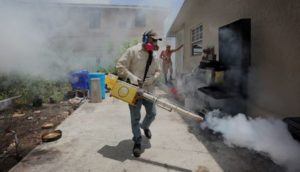Killing Mosquitos in the Age of Zika: AMVAC Considers Climate Change

Zika has arrived in the US, spurred on in part by global climate change. AMVAC, an agricultural-chemical company, produces the insecticide Dibrom, which aims to kill mosquitoes before they infect you.
“Zika is now here.”
With his statement on July 29, 2016, Dr. Thomas Frieden, the Director of the CDC, confirmed what had long been feared—Zika had found its way to the United States1.
First isolated in Uganda in 1947, reports of human illness from the Zika virus remained sporadic until 2007. In that year, an outbreak in Micronesia caused mild fevers in a few dozen people. Then, over the following 9 years, the virus popped up intermittently across several isolated Pacific islands, proving to be little more than a nuisance to those affected. In April of 2015, however, Zika struck again, only this time it was much more infective, and dramatically more aggressive. Starting in Brazil, Zika rapidly spread across South America, leaving thousands sickened for weeks with rashes, conjunctivitis, and severe bone pain. What’s worse, after the wave of initial illness, Zika was linked to a growing incidence of microcephaly and other related birth defects, as well as Guillan-Barre Syndrome, a progressive paralytic condition that, although temporary, leads to death in 5% of cases. Public health officials raced to stem the spread of Zika, but it outpaced their efforts in the Caribbean before making landfall in Miami in the summer of 2016.
While it remains uncertain why Zika suddenly became more virulent, its spread to new regions of the world is intimately tied to the effects of global climate change. The virus is primarily spread by the Aedes aegypti mosquito. Preferring hot, humid environments, Aedes aegypti has historically been contained to tropical regions of the world. With changing global climate though, its habitat has expanded into more temperate zones in Europe and North America2. In fact, mosquitos capable of transmitting Zika have recently been found as far north as Washington DC3.
Considering that the trends in the global climate are likely to put an increasing number of people at risk of infection, it is imperative that public health officials exhaust all resources at their disposal to halt the spread of the disease. With an effective vaccine unlikely to reach the market for years to come4, the most effective current weapon against Zika remains mosquito control. Thus, municipalities across much of South Florida have invested heavily in insecticide spraying programs.
 Mosquito-control worker spraying Dibrom insecticide in Miami
Mosquito-control worker spraying Dibrom insecticide in Miami
Source: British Broadcasting Company
 Plane spraying Dibrom insecticide over Miami
Plane spraying Dibrom insecticide over Miami
Source: New York Times
There are dozens of chemical compounds on the market that effectively kill adult mosquitos. However, one agent in particular, Dibrom—produced by AMVAC Chemical Corporation, a $400 million agricultural-chemical company out of Los Angeles, California—has been widely used by public health officials given its relative safety and ease of administration5,6. With Aedes aegypti mosquitos likely to spread further into the American heartland in coming years, AMVAC must carefully consider how its business should adapt to the opportunities and threats of climate change.
Opportunities:
Market demand for insecticides that are easy-to-spray, non-toxic, and effective is likely to increase in the future. AMVAC stands to primarily benefit as Dibrom is the most used agent on the market. Additionally, Zika virus and other vector-borne diseases stand to increase in incidence in the United States, and the public is likely to demand additional agents to kill larval mosquitos and other pests, like ticks and fleas, opening new potential markets for AMVAC.
Threats:
The continued use of Dibrom is by no means certain. Currently, Dibrom is classified as a “Restricted Use Insecticide” granting access only to governmental agencies7. While public health organizations across the world sprayed millions of pounds of Dibrom in the last year alone, its use has come under scrutiny.
Dibrom is sprayed as an “ultra-low volume fog” in which droplets are aerosolized and diffuse through the atmosphere. This formulation is difficult to target precisely, and Dibrom can accumulate in the environment where it is toxic to numerous plants and animals. Dibrom also breaks down rapidly to form dichlorvos, a known carcinogen linked to birth defects. These environmental and health concerns led hundreds of people to protest the use of Dibrom in Puerto Rico, even as that country was reeling from a massive Zika outbreak8. More recently, aerial spraying of Dibrom has been linked to the death of millions of honey bees in America9. Given a public that is increasingly aware and proactive about environmental and ecological damage, AMVAC should be wary of how Dibrom is used and perceived.
What AMVAC Should Do:
AMVAC recently expanded its production capacity of Dibrom and should continue to forecast future demand to ensure that it can supply its market. AMVAC should also boost R&D to improve upon the current formulation of Dibrom (aiming for increased stability, improved effectiveness, and reduced toxicity) and to create new and complimentary products. Additionally, AMVAC should pursue relationships with regulatory agencies to ensure that the use of Dibrom is secure in the future, and to push for greater access of Dibrom among private companies.
(795 Words)
References:
- Pam Belluck, Lizetter Alvarez, and Donald McNeil, “4 Zika Cases in Florida Were Likely Spread by Local Mosquitos, C.D.C. Says” The New York Times: July 29, 2016.
- Moritz Kramer, et al. “The Global Distribution of the Arbovirus Vectors Aedes aegypti and Ae. Albopictus” eLife: June 30, 2015.
- Centers for Disease Control and Prevention, “Zika Virus: Potential Range in US” http://www.cdc.gov/zika/vector/range.html, accessed November, 2015.
- Elijah Wolfson, “Zika Vaccines are on a Fast-Track, but it won’t be Fast Enough to Handle the Current Outbreak,” Quartz: August 5, 2016.
- Environmental Protection Agency, “Naled for Mosquito Control” https://www.epa.gov/mosquitocontrol/naled-mosquito-control, accessed November, 2016.
- Califronia Department of Public Health, “Safety of Pyrethrin and Pyrethroid Pesticides Used to Control Adult Mosquitos” http://www.cdph.ca.gov/HealthInfo/discond/Documents/SafetyofPyrethrinandPyrethroidPesticidesUsedtoControlAdultMosquitoes09-14.pdf, accessed November, 2016.
- Environmental Protection Agency, “Restricted Use Products Report,” https://www.epa.gov/pesticide-worker-safety/restricted-use-products-rup-report, accessed November, 2016
- Susan Scuttl, “What are Mosquito-Control Workers Spraying in Miami?” CNN: August 25, 2016.
- Sandee LaMotte, “Zika Spraying Kills Millions of Honeybees,” CNN: September 2, 2016.




Thanks for the interesting insight! This post gave me a lot of perspective on the mosquito abatement soundbites I have heard in the context of Zika. Your analysis makes me curious about several questions:
1. Do other companies sell Dibrom (Naled), or does AMVAC have the exclusive right to produce this agent? If AMVAC is (or will eventually be) subject to competitive pressure, how should it position itself?
2. I had heard about the Dibrom spray controversy because it contains a known carcinogen. Have there been, or will there be, longitudinal studies to evaluate the impact of Dibrom application on resident populations?
Thanks again for the well-presented info!
Dr. Mike! Thank you for exploring this important and timely issue in your blog post. I had not thought about this assignment from the perspective of organizations are actually benefitting from global climate change. Your post has made me feel increasingly wary about how AMVAC’s financial success is at once helping protect communities from the impact of an infection disease, while at the same time increased use of their product is causing significant negative environmental impacts.
As you mention in you “what should AMVAC do next” comments, I strongly agree that AMVAC needs to focus on redeveloping Dibrom to reduce the some of the negative environmental impacts. Even a step further, I think they should focus on developing products that have negligible impact in order to protect the environment and future sales. If they can do this, it’s likely they’ll gain more support in governmental and regulatory agencies, and perhaps among the public (if they can make it safe enough for consumer use!).
Dibrom is certainly a very controversial part of many nation’s strategies to combat the proliferation of the Zika virus. While I see your point that AMVAC can play critical role in our fight against Zika and the Aedes aegypti mosquito, I believe that the company should take a much more conservative approach by increasing testing for the negative side effects before aggressively increasing production capacity.
I can easily see U.S. regulatory measures erring on the side of precaution given our society’s increased focus on environmental and health side effects, just as how the European Food Safety Authority (EFSA) banned naled (the chemical in Dibrom) for agricultural usage (http://ec.europa.eu/food/plant/pesticides/eu-pesticides-database/public/?event=activesubstance.detail&language=EN&selectedID=1610). AMVAC should definitely prioritize the reduction of Dibrom’s negative effects because of the regulatory risk of a broader ban of Dibrom. Thanks for raising awareness of this!
Mike – thank you for your wonderful article! I was unaware of Dibrom’s use for managing Zika’s proliferation but surprised to see that, despite its egregious health effects, it is still so widely used. My own research shows that it is toxic to the human nervous system. Symptoms of exposure include headaches, nausea, and diarrhea! Further still, there appear to be non-negligible environmental/food chain harms created because it is also toxic to aquatic species at the “low end of the food chain,” like aquatic insects and frog larvae; essentially, fish food. It would be great to see AMVAC refine their formulations to address these concerns, as you rightly suggest. The other interesting approach to managing the proliferation of Zika is the use of CRISPR and gene drive technologies. I imagine AMVAC is not in the business of biotechnology, but its worth considering less harmful approaches to managing disease risk, nonetheless.
Hi Mike! Thanks for this “sick” article. Like every “red blooded” America, I’m “bugging out” that Zika is “going viral” in the U.S. as microcephaly really “sucks.” I’m afraid that “spraying and praying” only “scratches” the surface of this problem and that we can do better than just come up with solutions “on the fly.”
If those bug puns didn’t “zap” your energy, I’ll say that your article raised a number of questions for me — first, if Zika’s spread is indeed linked to climate change, is there a way to use a changing climate to stop the mosquito’s reproductive cycle? If climate change is rendering some places arid and others lush, will the net effect be to shift mosquito populated areas or spread them? What will this mean for the business model here?
Second, where does Zika go next? It sounds like there is a massive business opportunity for anti-mosquito businesses to work throughout the United States but I’m a little concerned that there is a perverse incentive for fumigation businesses to not do a great job. How can we prevent principal-agent problems here? If Zika continues to travel internationally, what will be the role of international institutions in leading the charge?
Finally, it sounds like dibrom has some pretty bad ecological effects — what about a more “targeted” solution like this mosquito-killing laser? https://www.fastcoexist.com/3059127/what-happened-to-the-mosquito-zapping-laser-that-was-going-to-stop-malaria/1 Great job!